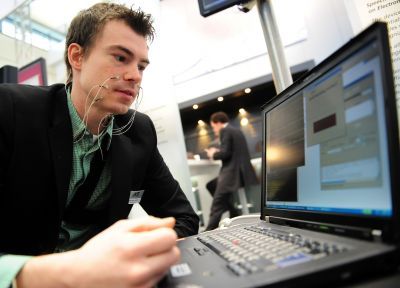The sound of silence: an end to noisy communications

It has happened to almost everyone. You are sitting on a train or a bus and someone right next to you is annoyingly shouting into his or her mobile phone.
But those days could soon be past with "silent sounds", a new technology unveiled at the CeBIT fair on Tuesday that transforms lip movements into a computer-generated voice for the listener at the other end of the phone.
The device, developed by the Karlsruhe Institute of Technology (KIT), uses electromyography, monitoring tiny muscular movements that occur when we speak and converting them into electrical pulses that can then be turned into speech, without a sound uttered.
"We currently use electrodes which are glued to the skin. In the future, such electrodes might for example by incorporated into cellphones," said Michael Wand, from the KIT.
The technology opens up a host of applications, from helping people who have lost their voice due to illness or accident to telling a trusted friend your PIN number over the phone without anyone eavesdropping - assuming no lip-readers are around.
The technology can also turn you into an instant polyglot. Because the electrical pulses are universal, they can be immediately transformed into the language of the user's choice.
"Native speakers can silently utter a sentence in their language, and the receivers hear the translated sentence in their language. It appears as if the native speaker produced speech in a foreign language," said Wand.
The translation technology works for languages like English, French and Gernan, but for languages like Chinese, where different tones can hold many different meanings, poses a problem, he added.
Noisy people in your office? Not any more. "We are also working on technology to be used in an office environment," the KIT scientist told AFP.
The engineers have got the device working to 99 percent efficiency, so the mechanical voice at the other end of the phone gets one word in 100 wrong, explained Wand.
"But we're working to overcome the remaining technical difficulties. In five, maybe ten years, this will be useable, everyday technology," he said.
Subscribe to Independent Premium to bookmark this article
Want to bookmark your favourite articles and stories to read or reference later? Start your Independent Premium subscription today.

Join our commenting forum
Join thought-provoking conversations, follow other Independent readers and see their replies